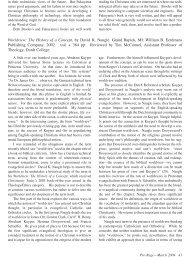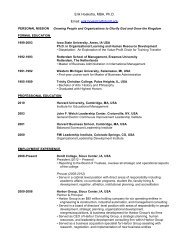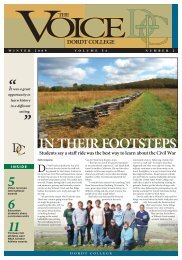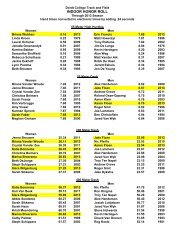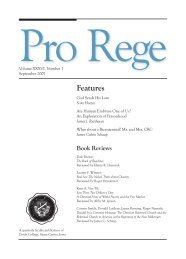June 2009 - Dordt College
June 2009 - Dordt College
June 2009 - Dordt College
Create successful ePaper yourself
Turn your PDF publications into a flip-book with our unique Google optimized e-Paper software.
Editor’s Note: Alida Sewell’s article was presented to the Sixteenth Century Conference in St Louis,<br />
Missouri, 2008.<br />
Nakedness and Shame<br />
in Calvin’s Writings<br />
by Alida Sewell<br />
My aim is to explore the link, which appears<br />
to be inevitable in Calvin, between nakedness and<br />
shame. Is this inevitability a result of his personal<br />
prudery Is it the cultural conditioning of his times<br />
Is there any room in his thinking for an appreciation<br />
of the naked body as God created it Why does he<br />
not more fully comment on the Genesis narrative,<br />
where it says that Adam and Eve were naked and<br />
not ashamed (Genesis 2.25) Calvin’s commentaries<br />
Alida Sewell has been Instructor of French at<br />
Northwestern <strong>College</strong> in Orange City, Iowa, for<br />
two years and is currently working on her Ph.D.<br />
from the Free University in Amsterdam, The<br />
Netherlands.<br />
and sermons on the stories of Adam and Eve, and<br />
Noah, and a few others will be analyzed to gain an<br />
understanding of Calvin’s thinking. The commentary<br />
on Genesis and the sermons on Genesis both date<br />
from Calvin’s later years—1554 and 1559 onwards<br />
respectively—and presumably express his mature<br />
thoughts. The translations from the French sermons<br />
are my own. For the Latin commentaries I have relied<br />
on published translations in English and Dutch.<br />
If beauty is in the eye of the beholder, so is shame,<br />
it seems. Where some people see nakedness plain<br />
and simple, others only see a shameful nakedness. For<br />
Calvin, bodily nakedness is strongly associated with<br />
shame and disgrace. He also lists nakedness among<br />
dire situations such as poverty, famine, diseases,<br />
and reproaches. He never expresses it as something<br />
positive, except that before the Fall “there was<br />
nothing but what was honorable …[;] our parents<br />
had nothing in themselves which was unbecoming<br />
until they were defiled with sin.” 1 The Fall, of course,<br />
caused the defilement of sin. Calvin wonders why<br />
deformity should appear in only one part of the<br />
body (and by that he means the genitals), since our<br />
whole human nature is infected by squalid sins. He<br />
concludes that it was enough for God that a certain<br />
shameful sign was conspicuous in the human body<br />
which would remind us of our sins. This is how he<br />
links the genitals especially with shame. 2 Augustine<br />
said something similar when he discussed shame and<br />
lust. 3 In the very first chapter of his Institutes of 1559,<br />
Calvin also links nakedness and shame. He writes,<br />
“For, as a veritable world of miseries is to be found<br />
in mankind and we are thereby despoiled of divine<br />
raiment, our shameful nakedness exposes a teeming<br />
12 Pro Rege—<strong>June</strong> <strong>2009</strong>




